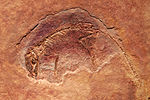Eomaia
| Eomaía | |
|---|---|

| |
| Eomaia | |
| Scientific classification | |
| Kingdom: | |
| Phylum: | |
| Class: | |
| Subclass: | |
| Infraclass: | |
| Genus: | Eomaia
|
| Species: | E. scansoria
|
| Binomial name | |
| Eomaia scansoria Ji et al., 2002
| |
Eomaia scansoria ('climbing dawn mother') is a recently discovered extinct mammal that may be one of the earliest ancestors of the eutheria yet to have been found.
The fossil was discovered in Yixian Formation, Liaoning Province, China. It dates from the Barremian Age, in the Lower Cretaceous.
The fossil is 10 cm in length and virtually complete. An estimate of the body weight is between 20-25g. It is exceptionally well-preserved for a 125-million-year-old. Although the fossil's skull is squashed flat, its teeth, tiny foot bones, cartilages and even its fur are visible.

According to palaeontologist Anne Weil, Eomaía was not a placental mammal. It was an early, primitive representative of the lineage of all placental mammals[1], including species of pig, horse, cat, dog, bat, mouse, rabbit, gorilla, chimpanzee, and human. The narrowness of the hips suggests an animal which gave birth to live young, but the babies were not well developed. This strongly indicates there was no well developed placenta.
According to an article published in Nature, the epipubis is present. This is highly unusual for eutherids, though not completely unknown from early representatives. Otherwise, this is a feature of marsupials, monotremes and non-mammalian therapsids.
It seems certain that Eomaía was a eutherid. It had a typical ancestral eutherian dental formula, 5.1.5.3/4.1.5.3 (incisors, canines, premolars, molars) The animal had five upper incisors, four lower incisors, and five premolars. These are not the typical numbers for modern eutherians. Modern eutherians have three incisors on top and bottom and four premolars.
The authors claim that on the basis of 268 characters sampled from all major Mesozoic mammal clades and principal eutherian families of the Cretaceous, Eomaía is placed at the root of the eutherian tree with Murtoilestes and Prokennalestes. Clearly, these three taxa are closer to living placentals than to living marsupials. Eomaia is placed in Eutheria by numerous apomorphies in the dentition, the wrist and the ankle.
There are even traces of hair. The previous record for such a feature was about 60 million years ago - this fossil is around 65 million years older. This is not to suggest that previous mammals had been hairless. Skeletal evidence suggests hair possibly appeared in non-mammalian ancestors back in the deep Triassic or Upper Permian. Fur hardly ever fossilizes and the amazing quality of the Liaoning fossils is highly unusual.
Reference
- Ji et al (2002), The earliest known eutherian mammal. Nature (416), p.816-822.
